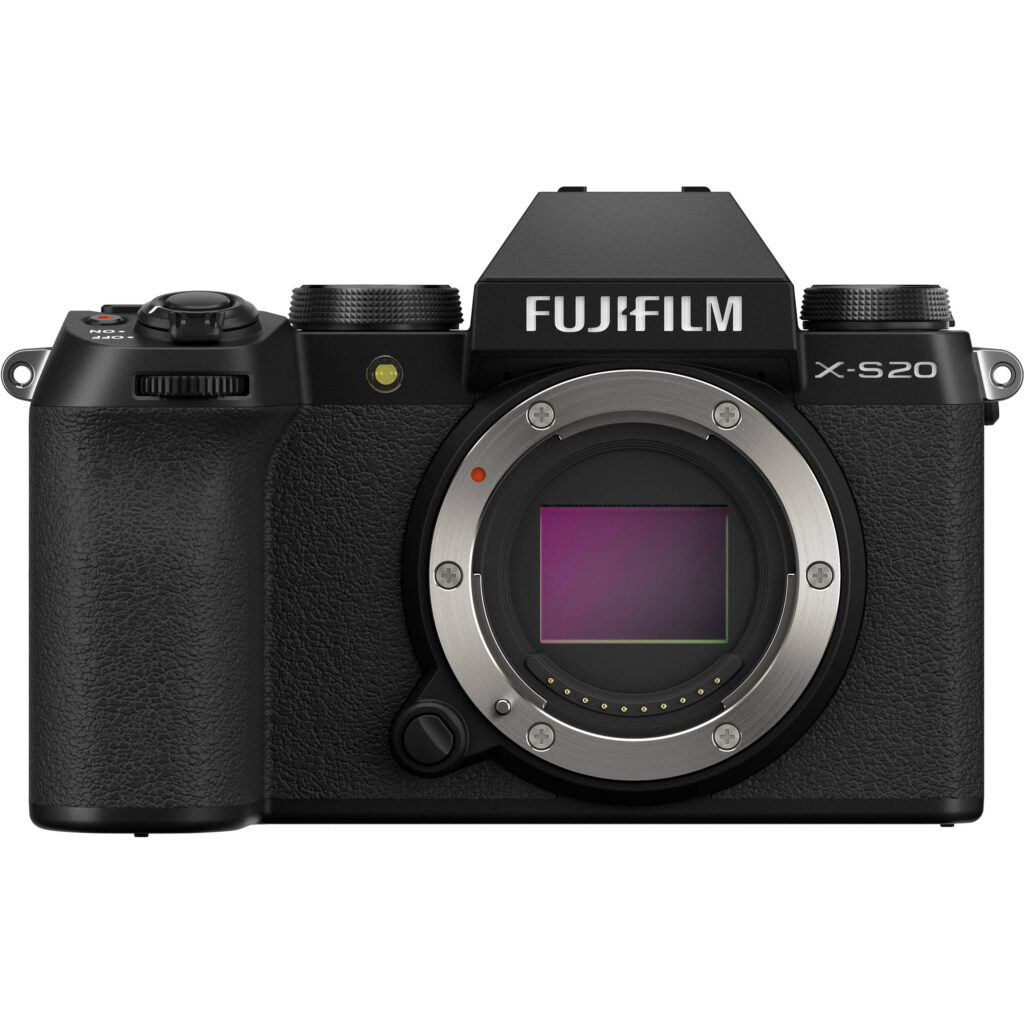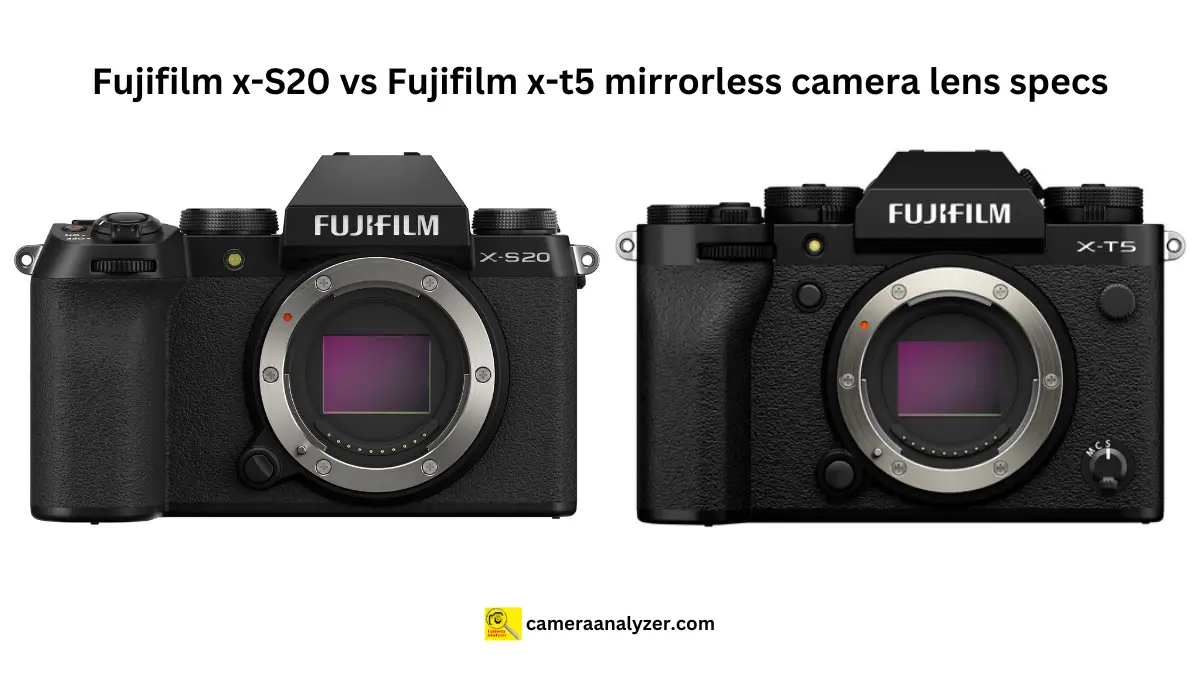Fujifilm has established itself as a leading brand in the mirrorless camera market, known for its commitment to image quality, innovative features, and a nostalgic design that appeals to photography enthusiasts and professionals alike. Two of its standout models are the Fujifilm X-S20 and the Fujifilm X-T5. While both cameras belong to the esteemed X series, they cater to different types of photographers with their unique specifications and capabilities. In this detailed comparison, we will delve into the lens specs, features, and overall performance of the Fujifilm X-S20 and X-T5, helping you decide which camera is best suited for your needs.
Overview of the Fujifilm X-S20
The Fujifilm X-S20 is a versatile mirrorless camera that combines high performance with a user-friendly design. It is aimed at enthusiasts and semi-professionals looking for a compact and capable camera that can handle various shooting situations.

Key Features of the Fujifilm X-S20
- Sensor: 26.1-megapixel APS-C X-Trans CMOS 4 sensor
- Processor: X-Processor 4
- Autofocus: 425-point phase detection AF system
- Video: 4K/30p video recording
- Viewfinder: 2.36M-dot electronic viewfinder
- LCD: 3.0-inch vari-angle touchscreen LCD
- ISO Range: 160-12800 (expandable to 80-51200)
- Continuous Shooting: 20 fps (electronic shutter), 8 fps (mechanical shutter)
- Stabilization: In-body image stabilization (IBIS)
- Connectivity: Wi-Fi and Bluetooth
Overview of the Fujifilm X-T5
The Fujifilm X-T5, on the other hand, is designed for advanced photographers and professionals who demand high performance, durability, and extensive manual controls. It continues the legacy of the X-T series with robust features and an appealing retro design.

Key Features of the Fujifilm X-T5
- Sensor: 40.2-megapixel APS-C X-Trans CMOS 5 HR sensor
- Processor: X-Processor 5
- Autofocus: 425-point phase detection AF system
- Video: 6K/30p video recording
- Viewfinder: 3.69M-dot electronic viewfinder
- LCD: 3.0-inch three-way tilting touchscreen LCD
- ISO Range: 160-12800 (expandable to 80-51200)
- Continuous Shooting: 20 fps (electronic shutter), 15 fps (mechanical shutter)
- Stabilization: In-body image stabilization (IBIS)
- Connectivity: Wi-Fi and Bluetooth
Comparing Lens Specs
When it comes to lens compatibility and performance, both the Fujifilm X-S20 and X-T5 offer impressive options. Fujifilm’s X-mount lens ecosystem is extensive, providing photographers with a wide range of choices to suit their specific needs.
Fujifilm X-S20 Lens Compatibility
The Fujifilm X-S20 is compatible with all Fujifilm X-mount lenses. Here are some popular lens options for the X-S20:
- XF 18-55mm f/2.8-4 R LM OIS
- Versatile standard zoom lens
- Optical image stabilization
- Fast and quiet autofocus
- Suitable for everyday photography
- XF 35mm f/1.4 R
- Classic prime lens
- Wide aperture for low-light performance
- Excellent bokeh and sharpness
- Ideal for portraits and street photography
- XF 10-24mm f/4 R OIS WR
- Ultra-wide-angle zoom lens
- Weather-resistant design
- Optical image stabilization
- Perfect for landscapes and architecture
Fujifilm X-T5 Lens Compatibility
The Fujifilm X-T5 also supports all X-mount lenses, and given its advanced sensor and processing power, it can fully exploit the capabilities of these lenses. Here are some recommended lenses for the X-T5:
- XF 16-55mm f/2.8 R LM WR
- Professional standard zoom lens
- Constant f/2.8 aperture
- Weather-resistant build
- Excellent for a variety of shooting scenarios
- XF 56mm f/1.2 R
- High-speed portrait lens
- Extremely shallow depth of field
- Superb image quality and bokeh
- Ideal for portraits and low-light photography
- XF 50-140mm f/2.8 R LM OIS WR
- Telephoto zoom lens
- Optical image stabilization
- Constant f/2.8 aperture
- Perfect for sports, wildlife, and event photography
You should also know the difference between mirrorless, cinema, and mirrorless cameras.
Detailed Comparison: Fujifilm X-S20 vs. Fujifilm X-T5
1. Sensor and Image Quality
Fujifilm X-S20
The X-S20 features a 26.1-megapixel APS-C X-Trans CMOS 4 sensor, which delivers excellent image quality with rich colors and sharp details. The X-Trans design minimizes moiré and false colors without the need for an optical low-pass filter.
Fujifilm X-T5
The X-T5 boasts a higher resolution 40.2-megapixel APS-C X-Trans CMOS 5 HR sensor. This sensor not only increases detail and resolution but also improves dynamic range and low-light performance. It’s ideal for photographers who require the utmost in image quality, such as landscape and commercial photographers.
2. Autofocus System
Both cameras feature a 425-point phase detection autofocus system, but the X-T5 benefits from more advanced processing capabilities thanks to the X-Processor 5, resulting in faster and more accurate AF performance, especially in challenging lighting conditions.
3. Video Capabilities
Fujifilm X-S20
The X-S20 offers 4K/30p video recording with excellent detail and color reproduction. It also supports F-Log recording for greater dynamic range and flexibility in post-processing.
Fujifilm X-T5
The X-T5 takes video capabilities to the next level with 6K/30p recording. This higher resolution allows for more detailed footage and greater flexibility in editing. The X-T5 also supports advanced video features like F-Log2, providing even greater dynamic range.
4. Build and Ergonomics
Fujifilm X-S20
The X-S20 has a compact and lightweight design, making it ideal for travel and everyday use. It features a deep grip for comfortable handling and a vari-angle touchscreen LCD for versatile shooting angles.
Fujifilm X-T5
The X-T5, while slightly larger and heavier, offers a more robust build with weather-sealing, making it suitable for professional use in various conditions. The camera has dedicated dials for ISO, shutter speed, and exposure compensation, catering to photographers who prefer manual controls.
5. Viewfinder and LCD
Fujifilm X-S20
The X-S20 features a 2.36M-dot electronic viewfinder and a 3.0-inch vari-angle touchscreen LCD. The viewfinder offers a clear and bright display, while the vari-angle LCD is perfect for vlogging, selfies, and shooting from unconventional angles.
Fujifilm X-T5
The X-T5’s viewfinder has a higher resolution of 3.69M-dots, providing a sharper and more detailed view. The 3.0-inch three-way tilting touchscreen LCD allows for flexible shooting, but it does not fully articulate like the X-S20’s vari-angle screen, which might be a consideration for vloggers.
6. Continuous Shooting and Performance
Fujifilm X-S20
The X-S20 can shoot up to 20 fps with the electronic shutter and 8 fps with the mechanical shutter. This makes it a solid choice for capturing fast-moving subjects.
Fujifilm X-T5
The X-T5 offers even faster continuous shooting speeds, with up to 20 fps using the electronic shutter and 15 fps with the mechanical shutter. This higher speed, combined with the advanced autofocus system, makes the X-T5 ideal for action photography.
7. Image Stabilization
Both cameras feature in-body image stabilization (IBIS), which helps reduce camera shake and allows for sharper images, especially in low-light conditions. However, the X-T5’s IBIS system is slightly more advanced, offering better stabilization performance.
8. Connectivity
Both the X-S20 and X-T5 come equipped with Wi-Fi and Bluetooth for easy image transfer and remote camera control via the Fujifilm Camera Remote app.
Tips for Choosing Between Fujifilm X-S20 and X-T5
1. Determine Your Photography Needs
Consider what type of photography you primarily engage in. If you need a compact, versatile camera for travel and everyday use, the X-S20 is a great option. If you require professional-grade performance, higher resolution, and robust build quality, the X-T5 is the better choice.
The head-to-head comparison of the features would also help greatly.
2. Evaluate Your Budget
While both cameras offer excellent value, the X-T5 is generally more expensive due to its advanced features and higher resolution sensor. Assess your budget and decide if the additional cost of the X-T5 is justified for your photography needs.
3. Consider Video Requirements
If video is a significant part of your work, the X-T5’s 6K video capability and advanced video features might be more appealing. However, if 4K video meets your needs, the X-S20 is still a highly capable option.
4. Handling and Ergonomics
Try handling both cameras if possible. The X-T5’s manual controls and robust build might appeal to those who prefer a more tactile shooting experience, while the X-S20’s compact design and vari-angle LCD are excellent for more casual and versatile use.
Conclusion
Both the Fujifilm X-S20 and Fujifilm X-T5 are exceptional mirrorless cameras, each with its unique strengths. The X-S20 is perfect for photographers seeking a compact, versatile, and user-friendly camera that performs well in various situations. The X-T5, with its higher resolution, advanced features, and robust build, is ideal for professional photographers and serious enthusiasts who demand the best in image quality and performance.
By understanding the key differences and evaluating your specific needs, you can make an informed decision on which camera best suits your photography style and requirements. Whether you choose the X-S20 or the X-T5, you’ll be equipped with a powerful tool that embodies Fujifilm’s legacy of excellence in imaging technology.
